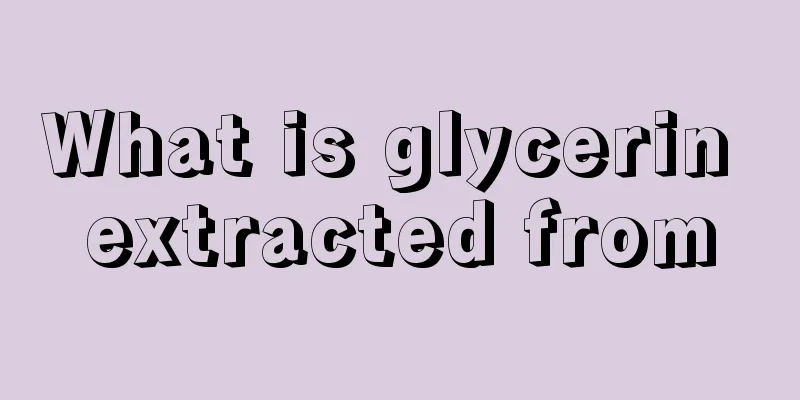What is glycerin extracted from

|
Glycerin generally refers to propylene glycol, which is an organic substance that appears as a clear, viscous liquid and has a wide range of uses in our lives. Glycerin has the functions of dynamic moisturizing and hydrating. More importantly, it is cheap and safe, and is popular among many women. If you use glycerin regularly, you must be interested in the process of its production. So, what is glycerin extracted from? Let’s take a closer look. The industrial production methods of glycerol can be divided into two categories: the method using natural oils as raw materials, the glycerol obtained is called natural glycerol; the synthetic method using propylene as raw material, the glycerol obtained is called synthetic glycerol.
Before 1984, all glycerin was recovered from the by-products of soap making from animal and vegetable fats. To date, natural oils and fats are still the main raw materials for the production of glycerin, of which about 42% of natural glycerin is obtained as a by-product of homemade soap and 58% comes from fatty acid production. Saponification reaction of fats and oils in the soap making industry. The saponification reaction product is divided into two layers: the upper layer mainly contains fatty acid sodium salt (soap) and a small amount of glycerol, and the lower layer is the waste alkali liquid, which is a dilute glycerol solution containing salts and sodium hydroxide, generally containing 9-16% glycerol and 8-20% inorganic salts. Grease reaction. The glycerin water (also called sweet water) obtained by the hydrolysis of oils and fats has a higher glycerin content than the soap-making waste liquid, about 14-20%, and inorganic salts 0-0.2%. In recent years, continuous high-pressure hydrolysis has been widely used. The reaction does not use a catalyst, and the resulting sweet water generally does not contain inorganic acids. The purification method is simpler than that of waste alkali liquid. Whether it is soap-making waste liquid or glycerin water obtained from oil hydrolysis, the glycerin content is not high and both contain various impurities. The production process of natural glycerin includes purification and concentration to obtain crude glycerin, as well as the refining process of crude glycerin distillation, decolorization and deodorization. Synthetic glycerol The various pathways for synthesizing glycerol from propylene can be summarized into two major categories, namely chlorination and oxidation. The propylene chlorination method and the propylene irregular acetic acid oxidation method are still used in industry.
This is the most important production method for synthetic glycerol, which includes four steps, namely high-temperature chlorination of propylene, hypochlorination of allyl chloride, saponification of dichloropropanol and hydrolysis of epichlorohydrin. The hydrolysis of epichlorohydrin to produce glycerol is carried out at 150°C and 1.37MPa carbon dioxide pressure in an aqueous solution of 10% sodium hydroxide and 1% sodium carbonate to produce a glycerol aqueous solution containing sodium chloride with a glycerol content of 5-20%. After concentration, desalination and distillation, glycerol with a purity of more than 98% is obtained. Propylene peracetic acid oxidation method Propylene reacts with peracetic acid to synthesize propylene oxide, which is isomerized into allyl alcohol. The latter then reacts with peracetic acid to form glycidol (i.e. glycidol), which is finally hydrolyzed into glycerol. The production of peracetic acid does not require a catalyst. Acetaldehyde is oxidized with oxygen in the gas phase. Under normal pressure, 150-160°C, and a contact time of 24 seconds, the acetaldehyde conversion rate is 11% and the peracetic acid selectivity is 83%. The latter two steps of reaction are carried out continuously in a reaction distillation tower with a special structure. After the raw material allyl alcohol and the ethyl acetate solution containing peracetic acid are fed into the tower, the tower bottom is controlled at 60-70°C and 13-20kPa. The ethyl acetate solvent and water are evaporated from the top of the tower, and the glycerol aqueous solution is obtained in the bottom of the tower. This method has high selectivity and yield, uses peracetic acid as an oxidant, does not require a catalyst, has a fast reaction speed, and simplifies the process. The production of 1 t of glycerol consumes 1.001 t of allyl alcohol, 1.184 t of peracetic acid, and 0.947 t of acetic acid as a by-product. At present, the production of natural glycerol and synthetic glycerol each accounts for almost 50%, while the propylene chlorination method accounts for about 80% of the production of synthetic glycerol. Natural glycerin accounts for more than 90% of the total production in my country.
Dilute the industrial-grade glycerin with 1/2 amount of distilled water, stir thoroughly, add activated carbon, and heat to 60-70°C for decolorization. Then, vacuum filter to ensure that the filtrate is clear and transparent. The dropping speed is controlled, and the filtrate is added to a column mixed with a pre-treated 732 type strong acid cation resin and a 717 type strong base cation resin to adsorb and remove electrolytes and non-electrolyte impurities such as aldehydes, pigments, and esters in glycerol. The glycerol solution after impurities are removed is subjected to reduced pressure distillation, the vacuum degree is controlled to be above 93326Pa, the kettle temperature is 106-108°C, and after most of the water is evaporated, the kettle temperature is raised to 120°C for rapid dehydration. When no water is produced, heating is stopped, and the material in the kettle is the finished product. |
<<: What can be used instead of glycerin
>>: Effects and functions of lotus root
Recommend
Donkey roll calories
Donkey rolls are a famous snack in our country. M...
TCM's description of the symptoms of lymphoma
In traditional Chinese medicine, lymphoma is a tu...
What are the early symptoms of lung cancer patients? Lung cancer patients have 4 early symptoms
The occurrence of lung cancer seriously endangers...
What positions to use during sex during the second trimester
Although it is said that women should try to avoi...
What tests are done for bladder cancer
Bladder cancer is a common malignant tumor of the...
Precautions before exercise
Although in modern society, many people claim to ...
How to treat belly button eczema?
Eczema is a skin disease that is not picky about ...
How to wash your face after eyelash extensions
With the rise of aesthetic concepts such as big e...
What kind of diet can make a breastfed baby gain weight
Some children are very fat when they are born, an...
What are the preparations before swimming
Swimming is a sport that most people like. Swimmi...
How to treat late-stage uterine cancer
Uterine cancer is also commonly known as endometr...
How to exercise abdominal muscles
We say that a man has a good figure and likes fit...
Can shelled peanuts be put in the microwave?
Microwave ovens are common electrical appliances ...
Symptoms of choice phobia, have you been affected?
In daily life, we are faced with various choices ...
Why does it hurt under the right rib when I inhale?
Many people have experienced rib pain. Another si...









